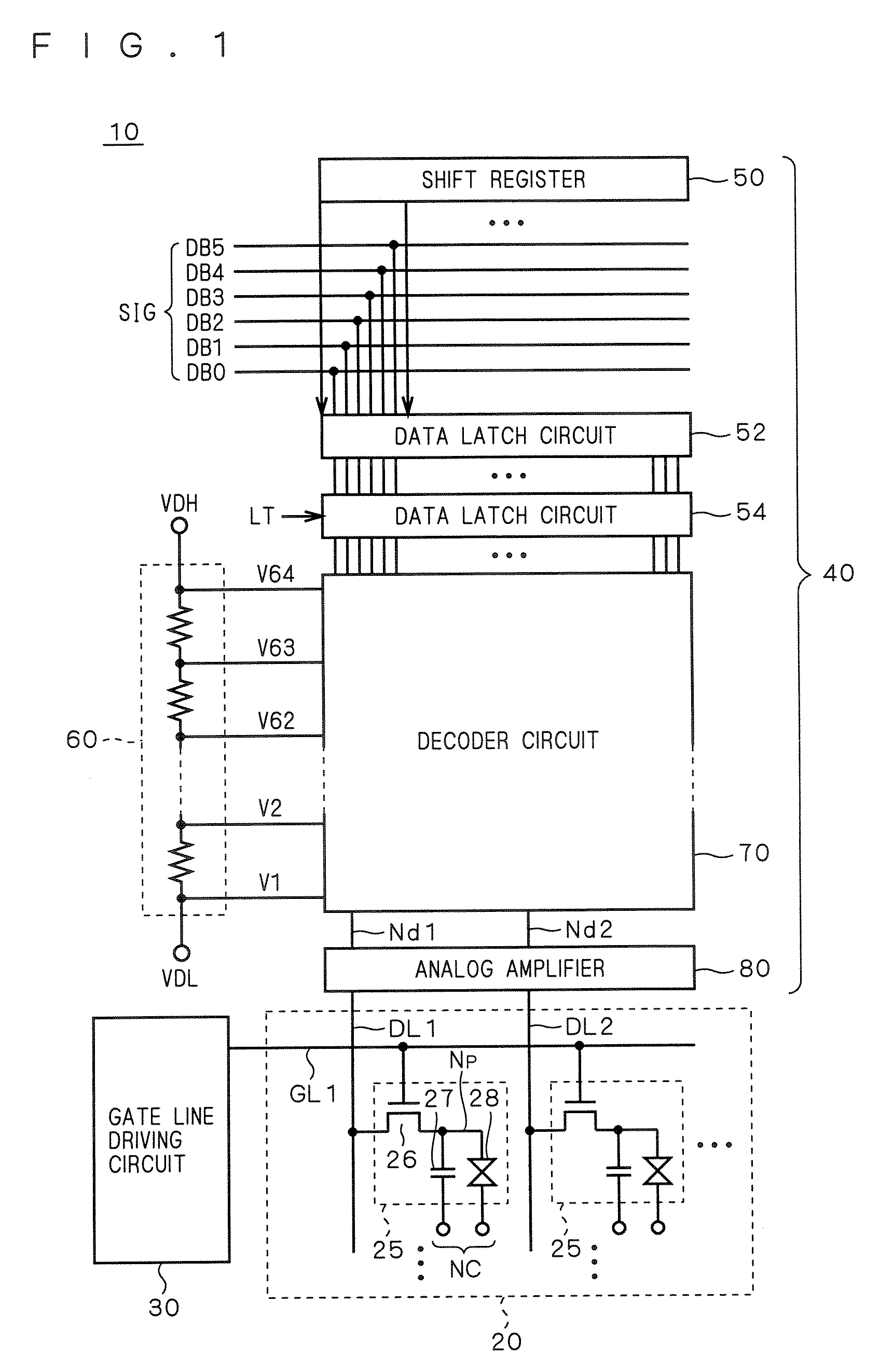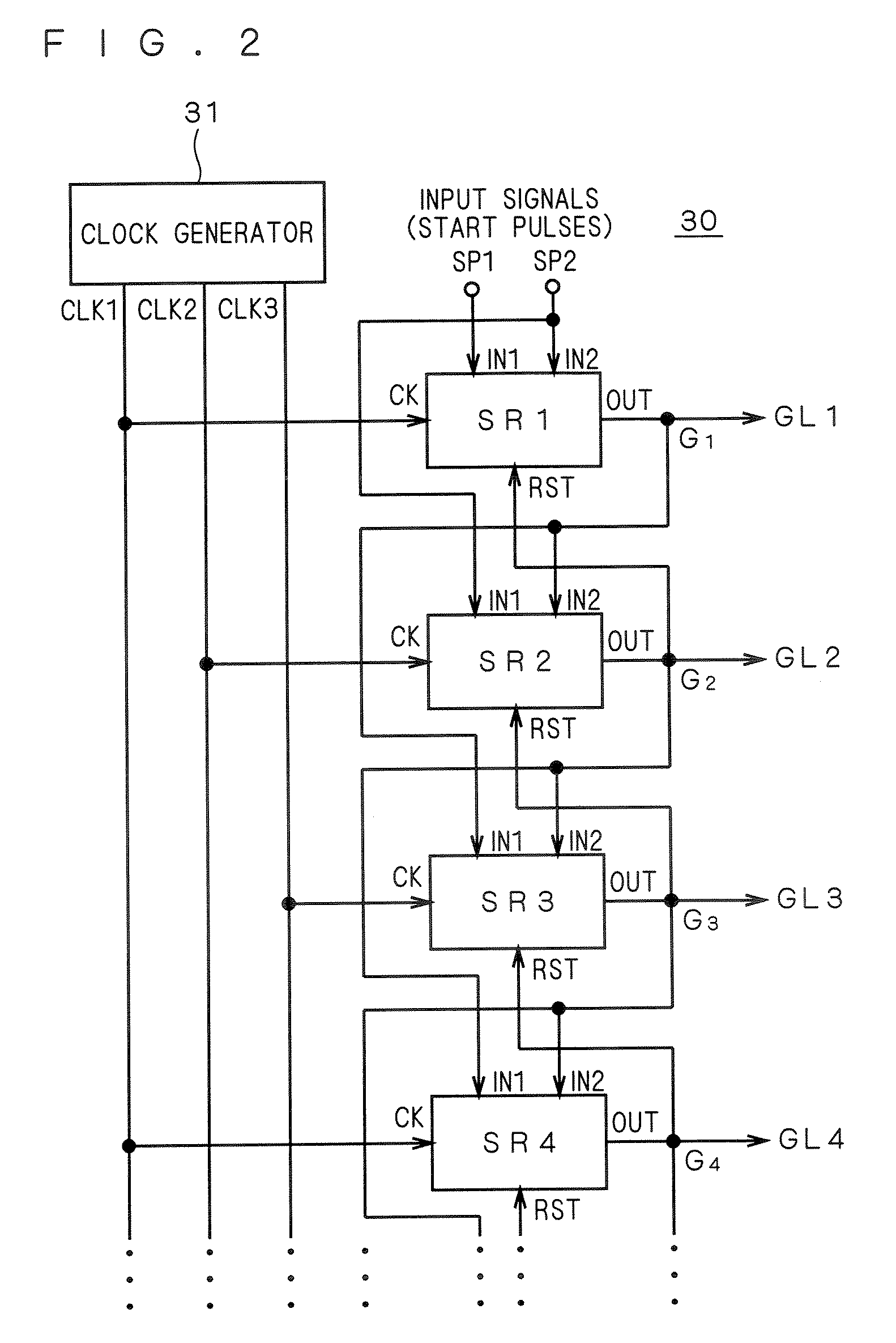Shift register circuit and image display apparatus having the same
a register circuit and register technology, applied in logic circuits, digital storage, instruments, etc., can solve the problems of reducing the driving capability of the first transistor, vddvth, and difficult to raise the first node to the maximum pre-charge level (vddvth), so as to suppress the effect of reducing the driving capability
- Summary
- Abstract
- Description
- Claims
- Application Information
AI Technical Summary
Benefits of technology
Problems solved by technology
Method used
Image
Examples
first preferred embodiment
[0048]FIG. 1 is a schematic block diagram illustrating the configuration of a display apparatus according to a first preferred embodiment of the present invention, where the entire configuration of a liquid-crystal display apparatus 10 is illustrated as a typical example of a display apparatus.
[0049]The liquid-crystal display apparatus 10 includes a liquid-crystal array 20, a gate line driving circuit (a scanning line driving circuit) 30, and a source driver 40. As will be clearly understood from the following description, the shift registers of the preferred embodiments of the present invention are provided in the gate line driving circuit 30.
[0050]The liquid-crystal array 20 includes a plurality of pixels 25 that are arranged in rows and columns. Gate lines GL1, GL2 . . . (collectively referred to as “gate lines GL”) are provided respectively for the rows of pixels (hereinafter referred to also as “pixel lines”), and data lines DL1, DL2 . . . (collectively referred to as “data lin...
second preferred embodiment
[0099]Field-effect transistors, including TFTs, are devices in which, when a voltage over the threshold voltage is applied to the gate electrode, a conductive channel is formed in the semiconductor substrate right under the gate electrode with a gate insulating film between them, and the conductive channel electrically connects the drain and source to achieve a conducting state. Accordingly, a field-effect transistor in the conducting state has a certain electrostatic capacitance (gate capacitance) between the gate and channel. That is, the field-effect transistor can function as a capacitive element in which the channel in the semiconductor substrate and the gate electrode serve as two electrodes and the gate insulating film serves as a dielectric layer. Such capacitive elements are called “MOS (Metal-Oxide Semiconductor) capacitive elements”.
[0100]FIG. 6 is a circuit diagram illustrating the configuration of a unit shift register circuit SR according to a second preferred embodime...
third preferred embodiment
[0108]In the unit shift register circuits SR of the first preferred embodiment, a charging circuit (the transistor Q8) and a boosting circuit (the capacitive element C2) are provided for the gate of the transistor Q3 (the node N3) that charges the node N1, whereby the node N3 is boosted to the level of 2×VDD−Vth. This causes the transistor Q3 to perform a non-saturated operation and so the node N1 can be rapidly charged (pre-charged).
[0109]In this preferred embodiment, this technique is applied also to the gate of the transistor Q8 that charges the node N3, where a charging circuit and a boosting circuit are provided also for the gate of the transistor Q8 so that the node N3 can be boosted to a still higher level than in the first preferred embodiment.
[0110]FIG. 7 is a circuit diagram illustrating the configuration of a unit shift register circuit according to a third preferred embodiment. In this preferred embodiment, too, the unit shift register circuit SR includes a charging circ...
PUM
 Login to View More
Login to View More Abstract
Description
Claims
Application Information
 Login to View More
Login to View More - R&D
- Intellectual Property
- Life Sciences
- Materials
- Tech Scout
- Unparalleled Data Quality
- Higher Quality Content
- 60% Fewer Hallucinations
Browse by: Latest US Patents, China's latest patents, Technical Efficacy Thesaurus, Application Domain, Technology Topic, Popular Technical Reports.
© 2025 PatSnap. All rights reserved.Legal|Privacy policy|Modern Slavery Act Transparency Statement|Sitemap|About US| Contact US: help@patsnap.com



